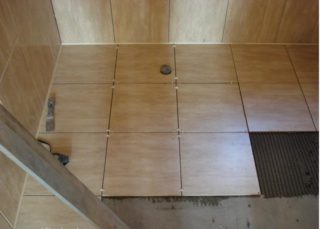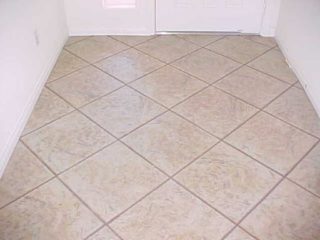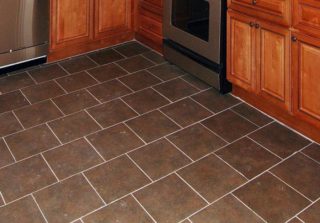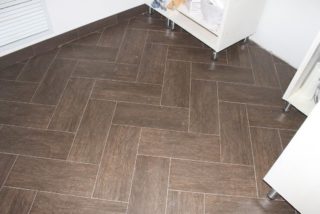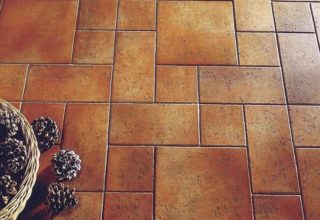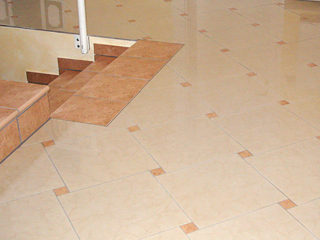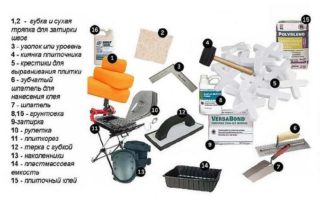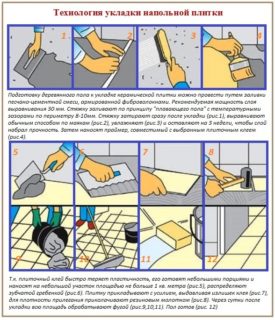Floor ceramics are flat rectangular plates made of fired clay. Tiles are laid on the floor in different patterns. The layout is made in simple squares, arranged diagonally, or in a complex mosaic combination of different sizes and patterns. The coating is laid on a cement mortar or special glue is used, the intermediate joints are filled with compounds called groutings.
Features and methods of laying tiles on the floor
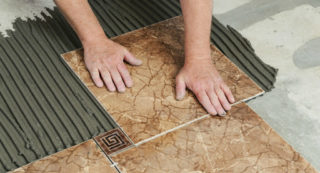
Ceramic coating is used in rooms of different functionality. When installing, take into account the peculiarities of working with a concrete, wooden or other base of the floor. Each option requires certain elements that are mounted using a specific technology.
Before laying tiles on the floor, several tasks are solved:
- choose a suitable type of base, level it or remove it if the old layer has become unusable;
- the glue for the tile layer is selected taking into account the humidity regime in the room during subsequent operation;
- if the scheme differs from the standard laying, markings are made on the floor area, along which the elements will be laid;
- for complex configurations, the tiles are cut in advance, then laid out on the floor to see the result and determine the detailed installation procedure;
- sometimes the laying is carried out from the corner, but in complex versions the first tile is placed in the center of the floor;
- for reliable fixation, the surface is treated with deeply penetrating soils, which must dry completely before starting work (4 - 5 hours).
A suitable pattern is selected after viewing the finished photographs of the floor using a particular type of tile. In the living room, elements are placed under the imitation of a laminate; in large rooms, it is preferable to put calm colors of the same tone. The bathroom allows for multi-color due to the small squaring of the floor. A light gloss will expand the room, while a dark, ray-absorbing surface (matte) will have the opposite effect.
Traditional
With a simple styling method, nuances are taken into account:
- the tiles must be the same size up to 1 mm, otherwise unequal seams will be visible;
- small factory defects and small defects immediately become noticeable with this installation option;
- the surface is monotonous.
It is important to check the evenness of the masonry and the dimensions of the perpendicular and adjacent gaps between the slabs, but in general this method does not require much skill.
The tiles are laid out in two rows located perpendicular to one another in the central area.
The method is used in rooms with irregular geometry, protrusions on the walls, such a layout is used to frame central panels on the floors of a large quadrature.
Diagonal
Features of the diagonal option:
- the mesh of the pattern has an angle of 45 ° with respect to the edge of the surface;
- square slabs look good, but rectangular parts are also used;
- an interesting view even when installing monochromatic parts;
- a lot of waste appears in the work due to cutting edge tiles;
- the original scheme visually expands the room.
The process of laying floor tiles assumes that the first row is installed using the standard method using rectangular elements. Their size on the side corresponds to the diagonal of the main parts. The second line is laid with cut triangular parts, which are placed with the hypotenuse down. Subsequent phalanges are laid out in horizontal stripes, while taking into account the diagonal direction.
Scattered
Features of this layout option:
- monotony is excluded, hides irregularities, a slight bias, gives comfort;
- looks good in the kitchen, in the hallway, on the balcony.
The masonry is staggered in horizontal stripes so that in the next row the seam between the tiles coincides with the center of the element of the previous line.
It is important to maintain the same size of the gap; for this, tile crosses of a certain size (1 - 4 mm) are taken. Wide seams will burn out sloppy and cumbersome, because at this size, you can clearly see the discrepancy between the corners and edges of the tiles.
First, lighthouse parts are placed to determine the level of the surface. Subsequent stripes are arranged in rows along the lighthouse. Use a wooden or rubber mallet for leveling. Lighthouses are removed as the laying is finished; it is important to control the horizontal level at each stage.
Herringbone
There are two options for placing the slabs:
- standard herringbone (under parquet);
- option with an attachment, while placing additional rectangular inserts of a small size in the form of a mosaic.
Monochromatic ceramics with imitation of different types of wood are used more often. If the surface of the elements is made in the form of a stone, this color is not used for the herringbone due to the unnatural combination of stone and parquet pattern.
The method involves unfolding the elements on both sides alternately, while observing the diagonal direction. As a result, waste is minimized. The drawing is used in the kitchen, bedroom, hallway, used in offices and common rooms.
After 5 - 6 m from the first strip, a coordinating line is drawn to find the best option between perpendicularity and diagonality. Measurements are taken along the line, which should turn out to be the same among themselves.
If in different places neighboring elements are compressed or diverged, the masonry is equalized until the solution has frozen.
Modular way
The result is achieved in two ways:
- installation of tile elements of different sizes, but selected so that their dimensions are multiple and do not protrude behind each other;
- masonry with large slabs, on which small details of different formats are applied.
You can design a drawing yourself, while taking into account that in a modular grid, a non-uniform pattern must be repeated many times. The store sells sets of tiles for such a layout and schemes for laying parts. It is imperative to use dividing crosses to form the same technological gaps.
Along the perimeter of the room, a gap of 1 cm is left between the coating and the wall in order to provide for thermal expansion.Wooden or plastic wedges are placed in between. As the glue hardens, take out crosses and inserts.
With shift
A large difference in the size of the fragments is suitable for the loft style. The masonry looks like intertwining stripes with a mean square in light or dark tones.
It is advisable to check the combination of elements upon purchase so that there is no error with the dimensions.
The drawing looks original in the interior if the shades and colors are well chosen. In small rooms, it is best not to use a variety of colors. Elongated rooms can be visually reduced by using transverse contrasting inserts in the drawing. On large areas, tiles can be laid in such a way as to highlight functional areas with shades.
Required tools and materials
Required tools:
- building or laser level;
- tile cutter, pliers, rubber hammer, emery stone;
- tape measure, pencil, cord;
- scraper, notched and rubber spatula;
- a bucket, a drill with a whisk, a grinder with a diamond wheel;
- rags, foam sponge, protective gloves.
For a traditional layout, tiles are taken by count, since it is easy to calculate the number of elements. Other layout methods require the use of a factor of 1, - 1.2, depending on the variant of the arrangement of parts in the scheme and the number of trimming points. Packs of one batch are taken from the warehouse in order to eliminate the discrepancy in the color shade. To process the joints, buy a grout of a similar or contrasting color scheme.
Substrate preparation and marking
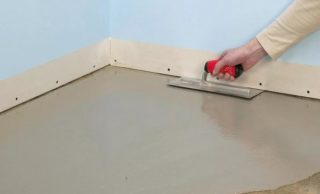
Laying tiles on the floor begins with putting the base in order. The area is leveled so that there is no slope and the angle between the vertical of the wall and the horizontal of the floor is 90 °.
Level the surface in different ways:
- cement screed;
- self-leveling solutions;
- chipboard sheets, moisture-resistant plywood.
The screed is performed on the concrete floor, for this, cement and sand are taken at a concentration of 1: 3, respectively. Water is added so that a thick dough is obtained, otherwise, when the screed dries, the screed will sit down and there will be grooves. Before pouring, put a plastic wrap, a vapor barrier or a layer of roofing material to protect it from moisture.
Self-leveling mixtures are poured onto the cleaned surface, they spread, forming a flat area. Sheets are stuffed on a wooden floor, parquet, they level the concrete.
Lay out the layout of the ceramic masonry in order to get the correct pattern. The tiles can be pre-laid out (if the room is small) or the direction axes can be marked with a cord.
DIY step-by-step instructions for laying tiles on the floor
The step-by-step process includes operations:
- applying glue to the surface;
- cutting tiles;
- stacking whole and cut elements;
- grouting of gaps.
Place the glue with a notched trowel on the area where the 4 tiles will be placed.The perforated relief will help to distribute the mixture evenly under the tiles. The elements are put on the mortar and, scrolling, pressed to the required level, taking into account the marking lines. For planting, they tap with a hammer, but it is undesirable to displace it strongly.
If the tile has dropped lower than necessary, it is removed and the mortar is placed.
It is easier to lay small elements, because there is a little glue mixture under them. Remove the crosses and dissolve the grout. It is applied with a spatula, filling the seam, then a strip is formed, and the remains are removed. Wipe the surface with a wet sponge after the solution has solidified in the seam.
Laying tiles on tiles
This method is not used if there is a sewage system, a water supply system, an electrician under the old coating, and there are no wells. Voids are revealed by tapping the surface and, if there are many of them, the old tiles are removed. It is undesirable to lay tiles on tiles if the height of the room is up to 2.4 m, since a new layer will lower the ceiling even more.
Provides bonding of the new and old layers. To do this, clean the surface, degrease it and make notches, and also remove the grout from the joints. Use a grinder to roughen the surface. After mechanical work, debris and dust are removed, and the surface is primed.
Laying on old ceramics is no different from normal work. The seams of the new coating must not match the old ones. The drawing is marked out and glue is applied, then the elements are installed.

